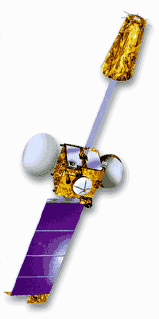| Home |
| Brief History |
| Space Programme |
| Satellite Program |
| Launcher Program |
| Indian Cosmonaut |
| ISRO |
| Web Search |
| A story of Indian Space Program |
| Satellites: : Aryabhata | APPLE | INSAT-1 | INSAT-2 | INSAT-3 | Bhaskara
| IRS | Rohini Launcher : : SLV | PSLV | ASLV | GSLV INSAT 2INSAT-2A | INSAT-2B | INSAT-2C | INSAT-2D | INSAT-2E INSAT-2A: Launched on 9 July 1992 from Kourou for location at 74°E. It entered service on 6 August 1992. It has a design life of seven years. The INSAT 2A's Transponders; • 124.5 SSPA 5930-6410/ 3705-4185 MHz and six (three backup; 2-for-1) 6735-6975/ 4510-4750 MHz up/down C-band and external C-band, all-India beam, 36MHz bandwidth, 32dBW EOL EIRP for 16 transponders, 34dBW for two. • Two (plus one backup) 50W TWTA 5858-5930 /2550-2630MHz up/down S-band all-India BSS beam, 36MHz bandwidth, 42 dBW EOL EIRP. • Single 402.75MHz Data Collection System transponder. • Single 406MHz Cospas/Sarsat search & rescue package. INSAT-2B: Specifications same as INSAT-2A. Launched on 22 July 1993 from Kourou and was declared operational at 93.5°E on 10 August 1993. INSAT-2C: Launched on 6 December 1995 from Kourou. The INSAT-2C replaced the imaging payload with improved telecom services. Declared operational at 93.5°E. The INSAT-2C's Transponders; • 12 C-band (2x50W TWTA, tx10WSSPA & 3x4W SSPA) all-India beam. • Six extended C-band (2x10W & 4x4W SSPAs), all-India beam. • Three 20W TWTA Ku-band all-India, 41dBW EIRP • Two (plus one backup) 50W TWTA 5858-5930 /2550-2630MHz up/down S-band all-India BSS beam, 36MHz bandwidth, 42 dBW EOL EIRP. • One 50W TWTA 2670-2690/2500Mhz up/down S-band all-India mobile communications beam. • 1 (plus one backup) 4W SSPA C-band all-India mobile communications feeder link. INSAT-2D: Launched on 4 June 1997 from Kourou. This satellite gave a big boost to television and telephone services. Specifications same as the -2C. However in October 1997, a major power failure occurred in the satellite and all attempts to bring it back were unsuccessful. It was finally abandoned. INSAT-2E: Launched on 03 April 1999, the 2550 kg satellite has a design life of 12 years and carries 17 C-band transponders of which 11 transponders have been leased to the International Telecommunication Satellite Organisation (Intelsat). For the first time, the satellite, carries an improved version of a very high resolution radiometer (VHRR) and a high-resolution charge coupled device (CCD) camera. The VHRR payload will be used for imaging the cloud coverage including cyclone formation. Data from the CCD camera will assist in cyclone analysis, local storm monitoring, heavy rain forecast, snow detection and long term climatic studies.
The satellite is configured with a single sided solar array consisting of four panels which will deploy in an accordion fashion by a single command operation. The satellite's power system provides regulated dual power bus wherein certain subsystems could be connected to any of the bus by ground command. Apart from regular and selected power buses, an uninterrupted power bus is available for the domestic power control electronics and telecommand functions. The solar panels are populated with gallium-arsenic/germanium cells to generate a net power of about 2240 Watts to meet spacecraft power demands with adequate margin. The payload power requirement alone is 1755 Watts. Sources and Resources
|
 The
INSAT-2E satellite
The
INSAT-2E satellite